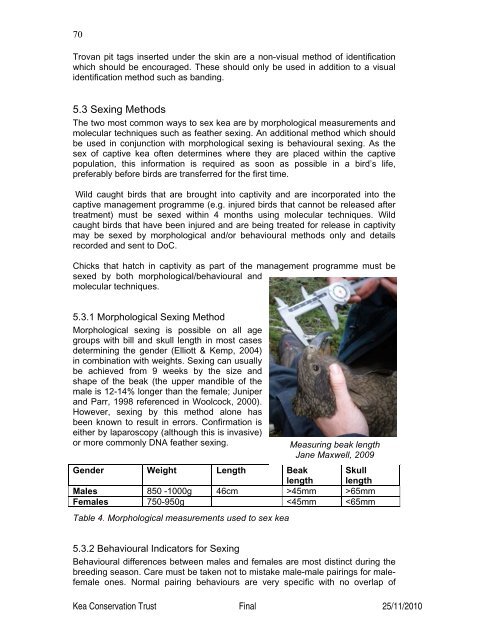(Nestor notabilis) Husbandry Manual - Kea Conservation Trust
(Nestor notabilis) Husbandry Manual - Kea Conservation Trust
(Nestor notabilis) Husbandry Manual - Kea Conservation Trust
You also want an ePaper? Increase the reach of your titles
YUMPU automatically turns print PDFs into web optimized ePapers that Google loves.
70<br />
Trovan pit tags inserted under the skin are a non-visual method of identification<br />
which should be encouraged. These should only be used in addition to a visual<br />
identification method such as banding.<br />
5.3 Sexing Methods<br />
The two most common ways to sex kea are by morphological measurements and<br />
molecular techniques such as feather sexing. An additional method which should<br />
be used in conjunction with morphological sexing is behavioural sexing. As the<br />
sex of captive kea often determines where they are placed within the captive<br />
population, this information is required as soon as possible in a bird’s life,<br />
preferably before birds are transferred for the first time.<br />
Wild caught birds that are brought into captivity and are incorporated into the<br />
captive management programme (e.g. injured birds that cannot be released after<br />
treatment) must be sexed within 4 months using molecular techniques. Wild<br />
caught birds that have been injured and are being treated for release in captivity<br />
may be sexed by morphological and/or behavioural methods only and details<br />
recorded and sent to DoC.<br />
Chicks that hatch in captivity as part of the management programme must be<br />
sexed by both morphological/behavioural and<br />
molecular techniques.<br />
5.3.1 Morphological Sexing Method<br />
Morphological sexing is possible on all age<br />
groups with bill and skull length in most cases<br />
determining the gender (Elliott & Kemp, 2004)<br />
in combination with weights. Sexing can usually<br />
be achieved from 9 weeks by the size and<br />
shape of the beak (the upper mandible of the<br />
male is 12-14% longer than the female; Juniper<br />
and Parr, 1998 referenced in Woolcock, 2000).<br />
However, sexing by this method alone has<br />
been known to result in errors. Confirmation is<br />
either by laparoscopy (although this is invasive)<br />
or more commonly DNA feather sexing.<br />
Gender Weight Length Beak Skull<br />
length length<br />
Males 850 -1000g 46cm >45mm >65mm<br />
Females 750-950g












